So, this is it, Ferrari’s Enzo replacement. Wait for it, it’s been named LaFerrari. Huh? The look is a little challenging too, that’s why we’ve started with the side profile above. There’s quite a bit of 458 Italia in the silhouette, which is good, but we’re pretty sure some other angles might leave you scratching your head. However, if you bear with it, the styling does grow in appeal.
As we expected the LaFerrari hypercar is powered by a petrol-electric drivetrain. The 6.3 litre V12, with a 9250rpm redline, does the lion’s share of the work, pumping out 800CV (588kW). The electric system complements that with an extra 163CV (120kW). That means the combined HY-KERS power output is 963CV (708kW). There’s the not so small matter of more than 900Nm of torque to be had as well.
For now, Ferrari remains a little coy on performance stats for the LaFerrari, saying only that 100km/h will take less than 3 seconds, 200km/h requires less than 7 seconds, while the nominate 15 seconds flat to reach 300km/h. It can reportedly lap the Fiorano circuit in 1 minute 20 seconds, which is 5 seconds quicker than the Enzo it replaces. Unsurprisingly, the LaFerrari is being labelled the fastest road car Ferrari has ever made.
The LaFerrari is a technological showpiece in all aspects. Four different types of carbon fibre have been used in its creation and its active aero package was tuned in Ferrari’s F1 wind tunnel. Further milking the company’s F1 heritage, the fixed-driver’s seat was designed in consultation with Fernando Alonso and Felipe Massa and its the pedal box that adjusts to suit each driver’s height.
Now, the name: LaFerrari. If you’re being polite you’d say it was a bloody stupid name. Yet, we’re told it’s all to do with excellence.
Ferrari’s President, Luca di Montezemolo said, “We chose to call this model LaFerrari because it is the maximum expression of what defines our company—excellence.
“Excellence in terms of technological innovation, performance, visionary styling and the sheer thrill of driving. Aimed at our collectors, this is a truly extraordinary car which encompasses advanced solutions that, in the future, will find their way onto the rest of the range, and it represents the benchmark for the entire automotive industry.”
Only 499 of Ferrari’s collectors will be able to call the LaFerrari their own and earlier reports suggest the order book is already full. Pricing is yet to be confirmed but it will expensive, very expensive!
The LaFerrari unveiled at Geneva
Maranello, 5th March 2013 – The wraps are finally off the LaFerrari. The Prancing Horse’s eagerly-anticipated limited-series special, of which just 499 will be built, made its world debut today at the Geneva International Motor Show.
“We chose to call this model LaFerrari,†declared Ferrari’s President, Luca di Montezemolo, “because it is the maximum expression of what defines our company – excellence. Excellence in terms of technological innovation, performance, visionary styling and the sheer thrill of driving. Aimed at our collectors, this is a truly extraordinary car which encompasses advanced solutions that, in the future, will find their way onto the rest of the range, and it represents the benchmark for the entire automotive industry. LaFerrari is the finest expression of our company’s unique, unparalleled engineering and design know-how, including that acquired in Formula 1.â€
For Ferrari the development of a limited-series special like the LaFerrari represents an opportunity to experiment with all the technological solutions that will later filter down onto the production cars. Of particular significance in this context is the introduction of the hybrid system which, making full use of the Scuderia Ferrari’s F1 KERS know-how, has resulted in a solution that exalts Ferrari’s fundamental values – performance and driving thrills. The hybrid technology used, known as HY-KERS, represents the perfect combination of maximum performance and lower emissions. LaFerrari in fact emits just 330 g/km of CO2 but without resorting to electric-only drive which would not fit the mission of this model. The HY-KERS system is, however, designed so that in future applications a car can be driven using exclusively electric power for a few kilometres and, during development testing, a full-electric version of LaFerrari achieved just 220 g/km of C02 emissions on the combined cycle.
The LaFerrari is equipped with dynamic controls that are integrated for the first time ever on a Ferrari road car with active aerodynamics and the HY-KERS system. Thanks to Ferrari’s proprietary logic which govern all the systems, the car can achieve absolute levels of performance, aerodynamic efficiency and handling without any form of compromise in any area. A very advanced and uncompromising approach was also taken with the interior design which features an HMI inspired by F1 single-seaters.
Architecture
The LaFerrari’s architecture posed the first challenge for the Prancing Horse team at the planning stage of the design. The aim was to achieve ideal weight distribution (59% at the rear) and a compact wheelbase despite the extra bulk of the hybrid system. The result is that all of the masses are situated between the car’s two axles and as close as possible to the floor to lower its centre of gravity (by 35 millimetres) and thereby guarantee dynamic handling and compact dimensions.
The layout of the cabin made a significant contribution in this regard. The seat is fixed and tailored to the driver while both the pedal box and steering wheel are adjustable. The driving position is similar to that of a single-seater and was designed after consultation with the Scuderia Ferrari drivers, Fernando Alonso and Felipe Massa, who played an active role throughout the entire development process.
The LaFerrari’s chassis features no less than four different types of carbon-fibre, all hand-laminated and autoclave-cured in the racing department using the same design and production methods as the Formula 1 car. This helped optimise the design: various functions were integrated (e.g. seats and battery compartment) into the chassis to improve torsional rigidity (+27%) and beam stiffness (+22%) whilst cutting weight.
Powertrain
The LaFerrari is the first car in Ferrari history to be powered by the HY-KERS system. The ICE represents the pinnacle of engine development and research, with a 6262 cc V12 that punches out 800 CV and revs to a maximum of 9,250 rpm, a record for an engine of this displacement. It also features a very high 13.5:1 compression ratio and a high specific output equal to 128 CV per litre. The engine is coupled with a 120 Kw (163 CV) electric motor, giving it a combined power output of 963 CV.
The high torque levels available at low revs from the electric motor allowed the engineers to optimise the internal combustion engine’s performance at higher revs, thus providing a constant supply of exceptional power throughout the rev range. Total torque generated is in excess of 900 Nm. The hybrid system is composed of two electric motors developed in collaboration with Magneti Marelli – one powering the driven wheels and the second the ancillaries – and a battery pack attached to the floor of the chassis consisting of cells that are assembled in the Scuderia Ferrari department where the KERS for the F138 is also made. The Scuderia’s expertise allowed considerable savings in weight and size of the individual components and the batteries weigh just 60 kg while providing the highest energy density possible for this kind of application.
The batteries are charged in different ways: under braking (even hard braking with the ABS active) and every time the V12 produces more torque than required, such as in cornering. In the latter instance, rather than the being sent to the wheels, the excess torque is converted to energy and stored in the batteries.
The electric motor is coupled with the F1 dual-clutch gearbox to the benefit of optimal weight distribution, but also to boosting energy efficiency as torque is instantly available to the wheels and, vice versa, from the wheels to the electric motor in recharging.
Aerodynamics
Active aerodynamics play an essential role, as they allow a complete adjustability of the car’s configuration to attain LaFerrari’s exceptional performance.
The engineers’ aim was to deliver the highest degree of aerodynamic efficiency ever achieved with any road car, with a coefficient of nearly 3, thanks to technical solutions honed with CFD analysis and fine-tuned in the F1 Wind Tunnel.
To boost efficiency, the LaFerrari sports active aerodynamic devices front (diffusers and guide vane on the underbody) and rear (diffusers and rear spoiler) which generate downforce when needed without compromising the car’s overall drag coefficient. These devices deploy automatically on the basis of a number of different performance parameters which are monitored in real time by the car’s dynamic vehicle controls, thus guaranteeing the ideal configuration on the basis of the driving conditions.
Control systems
One further innovative aspect of the LaFerrari is the integration of its active aerodynamics and hybrid system with the other dynamic control systems aboard. This means the car responds intelligently to driver inputs, making for a seamless blend of unprecedented performance and unparalleled driving emotions.
Proprietary Ferrari algorithms deliver optimal integration of the electric motor and V12 for instantaneous response. In cornering, for instance, the HY-KERS keeps the V12’s revs high to guarantee better acceleration on exit.
The LaFerrari’s Brembo braking system is also integrated with the hybrid system, and incorporates several new features, including new lightweight callipers designed to guarantee correct cooling and carbon-ceramic material (CCM) discs featuring a new composition.
The car’s extreme performance potential called for a different tyre set-up, with 265/30 R 19 Pirelli P-Zeros on the front and 345/30 R 20s on the rear.
All in all the car guarantees maximum driving thrills in every situation and performance levels are top level: 0-100 km/h in less than 3 seconds and 0-200 km/h in under 7 seconds, a lap time at Fiorano of under 1’20†– 5 seconds faster than the Enzo and over 3 seconds faster than the F12berlinetta. LaFerrari is thus the fastest road car in Maranello’s long history.
Styling The Ferrari design team led by Flavio Manzoni developed the LaFerrari’s styling working in close synergy with the engineers to emphasise the exacting link between form and function. The result is an extreme, innovative design which retains close links to the marque’s tradition. This is most evident in its side profile: the car has a sharp, downward-sloping nose and a very low bonnet which emphasises its muscular wheelarches, a clear nod to the gloriously exuberant forms of late-1960s Ferrari sports prototypes.
The LaFerrari’s body has been given a sculptural treatment heavily influenced by its clearly F1-inspired aerodynamics and a tail section that exudes uncompromising sportiness.
Inside there’s a newly-designed steering wheel sporting all the major commands, and the gear-shift paddles are now longer and more ergonomic. The signature bridge on which the F1 gearbox functions are clustered has taken on a sleek, suspended wing-like shape. The whole interior, in fact, has a fiercely track-inspired, pared-back allure.
The Ferrari range
Aside from the new limited-series special, the Ferrari stand also features the complete range which is the most wide-ranging and critically acclaimed in its entire history. The five models all share the same Ferrari DNA in terms of performance, driving pleasure and technology, yet each one has its own strongly unique identity, in line with the company’s philosophy of “different Ferraris for different Ferraristiâ€.
Ferrari’s 12-cylinder GT sports car prowess is represented at Geneva by the FF, the very first four-seater and four-wheel drive in Prancing Horse history. It will be sporting a Grigio Ingrid livery with an elegant glass roof and Iroko interior. The FF is also now seamlessly integrated with Apple technologies, thanks to direct access to the infotainment system via SIRI voice commands and the adoption of two iPad Minis as the entertainment system of choice for the rear seat passengers.
Blistering performance and sublime driving pleasure even at low speeds are assured behind the wheel of the multi-award-winning F12berlinetta, which is powered by a mid-front V12. Unique handling characteristics, extreme aerodynamics and an innovative yet classic design are its signatures. The car on show at Geneva has a Grigio Silverstone livery and a Sella di Cavallo interior.
Moving on to the 8-cylinders, the California 30, in sophisticated Nero Stellato with a Crema interior, is a convertible GT that uncompromisingly marries sportiness and versatility. The California’s already-massive popularity with both press and public alike grew still further after its V8’s output was upped by 30 hp to 490 hp, and 30 kg was slashed off its overall weight.
The blistering 458 Italia is a sublime, thoroughbred sports car. It and its drop-top sibling, the 458 Spider, are equipped with the same extraordinary mid-rear-mounted V8 engine which was named International Engine of the Year in both 2011 and 2012. These two models continue Ferrari’s glorious tradition with this particular layout. The coupé seen at Geneva sports an aggressive Bianco Avus livery and sleek black interior with carbon-fibre trim, while the Spider, which dominates the Tailor-Made extreme personalisation area, takes its inspiration from the legendary 1957 250 Testa Rossa that sold for a record 16 million dollars at auction at Pebble Beach in 2011. It has the same red and blue livery and a host of competition car details in its cabin, not least of which are suede-upholstered seats and Alutex trim.
LaFerrari technical specifications
HY-KERS system
- Total maximum power: 963 CV
- Total maximum torque: >900 Nm
- V12 maximum power:* 800 CV @9000 rpm
- Maximum revs: 9250 rpm
- V12 maximum torque: 700 Nm @6750 rpm
- Electric motor output: 120 Kw (163 CV)
- CO2 emissions:** 330 g/km
Performance
- Maximum speed: over 350 km/h
- 0–100 km/h: <3 sec
- 0–200 km/h: <7 sec
- 0–300 km/h: 15 sec
ICE
- Type: 65-deg. V12
- Bore and stroke: 94 x 752 mm
- Total displacement: 6262 cc
- Compression ratio: 13.5:1
- Specific power: 128 CV/l
Dimensions
- Length: 4702 mm
- Width: 1992 mm
- Height: 1116 mm
- Wheelbase: 2650 mm
- Weight distribution: 41% fr, 59% r
Gearbox
- 7-speed DCT
Suspensions
- Front: double wishbones
- Rear: multi-link
Tyres
- Pirelli P-Zero
- Front: 265/30 – 19
- Rear: 345/30 – 20
Carbon ceramic brakes
- Brembo
- Front: 398 x 223 x 36 mm
- Rear: 380 x 253 x 34 mm
Electronic controls
- ESC stability control
- High performance ABS/EBD Sistema frenata anti bloccaggio prestazionale /electronic brake balance
- EF1-Trac F1 electronic traction control integrated with the hybrid system
- E-Diff 3 third generation electronic differential
- SCM-E Frs magnetorheological damping with twin solenoids (Al-Ni tube)
Aerodynamics
- active
* with dynamic ram effect
**Undergoing homologation
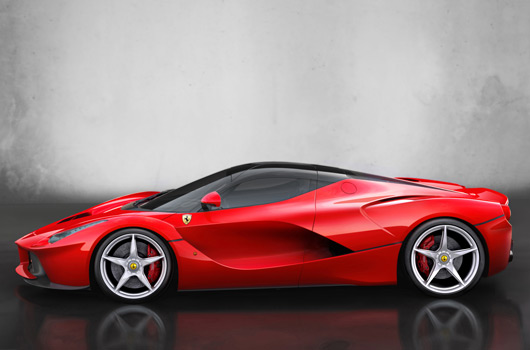
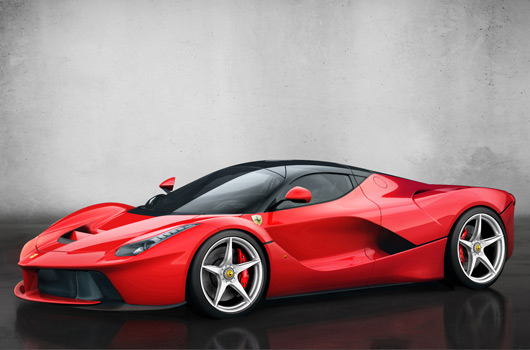
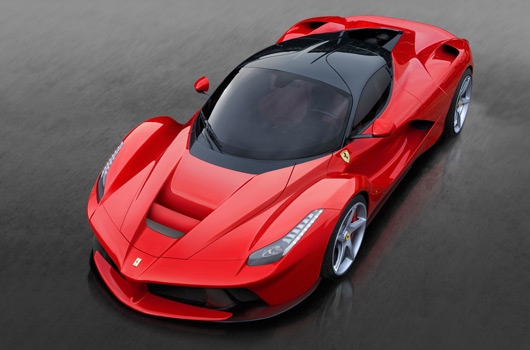
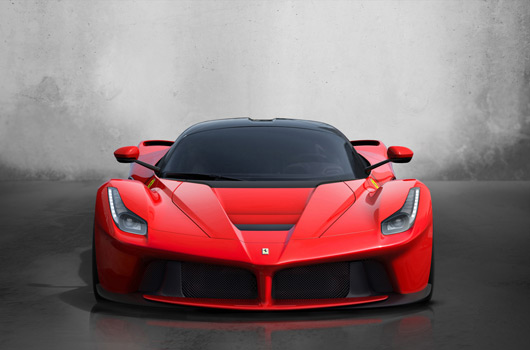
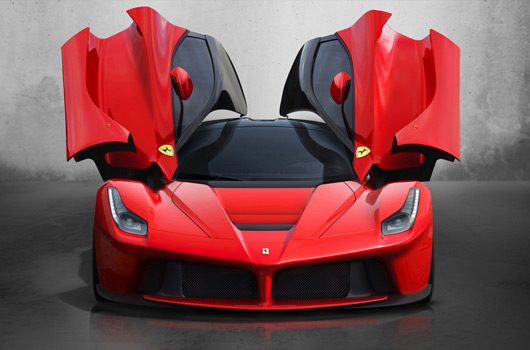
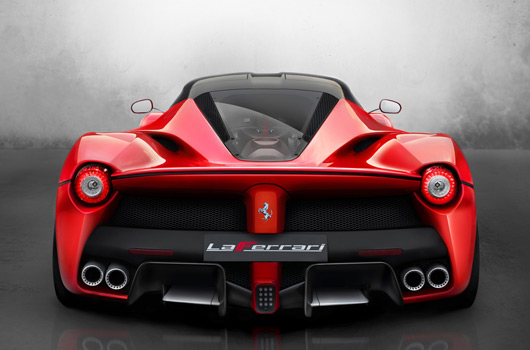
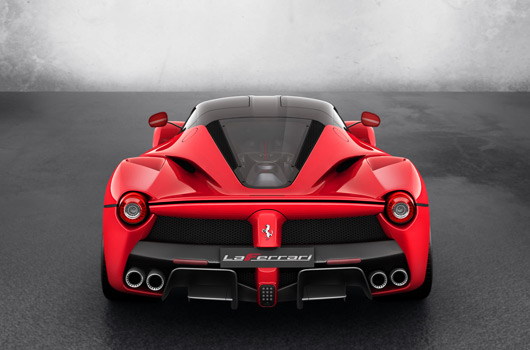
19 replies on “Geneva 2013: LaFerrari revealed”
I think the side view of the car is the least attractive one! Front three quarter view makes you want to cancel your LaFerrari and save your money and just buy a 458 instead, but the front and rear are rather racy in my eyes!
Yeah nah I think I’ll take the McLaren P1 thanks.
Sometimes the artistic pics are a little overdone, and I think in this case they’ve done no favours for the LaFerrari. If you look at the video, the car doesn’t seem like some sort of mirrored finished paint job as depicted in the artwork.
But yeah, not sure on the name… F40, F50, LaFerrari wth 😛
I don’t mind the looks, and dig the rear diffusers.
The name? Not a fan! Just sounds too soft for the what is a brutal car.
Lambo’s hypercar car Veneno is named after a fighting bull that killed a matador. I like that. The car is daring you to get in and try and tame the wild beast.
LaFerrari? That is daring you to get in and cruise down to Leichardt to get a latte (skim please)!
name sounds like a trattoria in concord.
car looks great to me. i like it a lot, but probably won’t be buying one, due to the silly name.
LaFerrari – WTF! they’ve go to be having us on. That is the stupidest car name….. in the world.
Looking good.
Where is the details on the P1 😀
[…] strictly-limited LaFerrari hypercar has reportedly been sold, although we suspect that really means there’s sufficient […]
[…] has complemented its release of the LaFerrari with a suite of six videos. They are a bit nerdy in parts, but it’s also fascinating to get a […]
[…] Luca di Montezemolo officially launched the LaFerrari in Geneva a few days ago he said there were already 700 written expressions of interest for the […]
I’ve just been reading the numbers again. It’s extraordinary. 0-300kmh time is the most extraordinary one of all. Consider this, 918 Spyder is supposed to get there in 27 seconds, and this thing does it in 15???
[…] Ferrari LaFerrari […]
[…] with 830kW (1115hp) available the Agera R has more power than the LaFerrari (708kW) or the P1 (675kW) and, crucially, at 1418kg with fluids they say it weighs less as well. […]
[…] has released this behind the scenes clip featuring its new 588kW LaFerrari hypercar. Consider it a teaser of a new promo to come on the next week or two. As well as visuals, […]
[…] once again and follow the proven route it took with the MC12 (pictured) by knocking-off the new LaFerrari […]
[…] a short and sweet video from Ferrari showing Fernando Alonso at the wheel of the LaFerrari at the company’s famous Fiorano test […]
[…] isn’t responding to the gauntlets thrown down by the more powerful and faster rivals—LaFerrari (708kW) and McLaren P1 (675kW), but it’s hard not to draw any other conclusions. Yet, if […]
[…] you can see a pair of LaFerraris take to the Fiorano test track. Maranello’s hybrid hypercar is powered by a 588kW 6.3 litre V12 complemented by an extra 120kW of electric power. The combined […]
[…] 708kW LaFerrari is the latest in the triumverate of hybrid hypercars to attack the Nürburgring […]